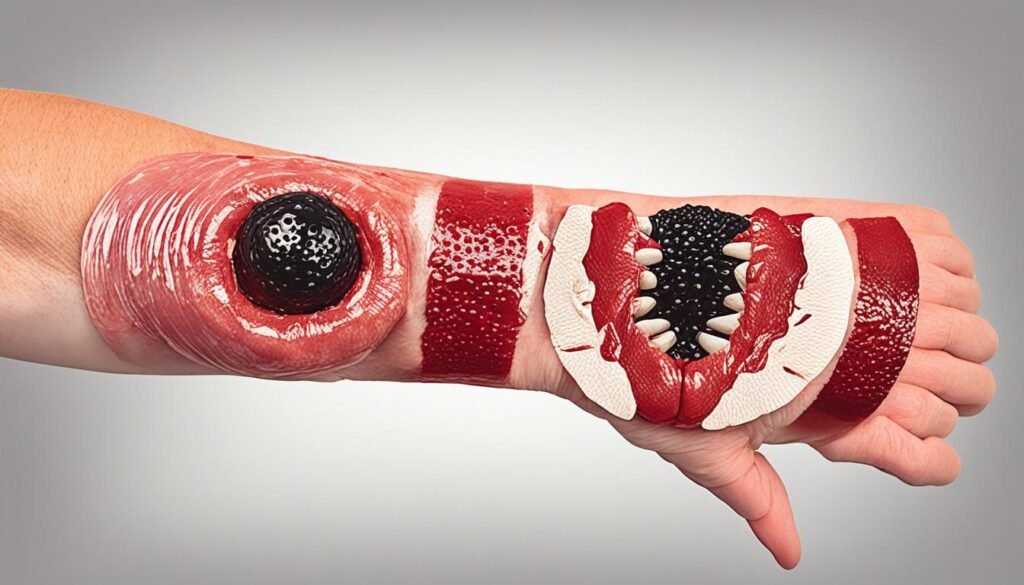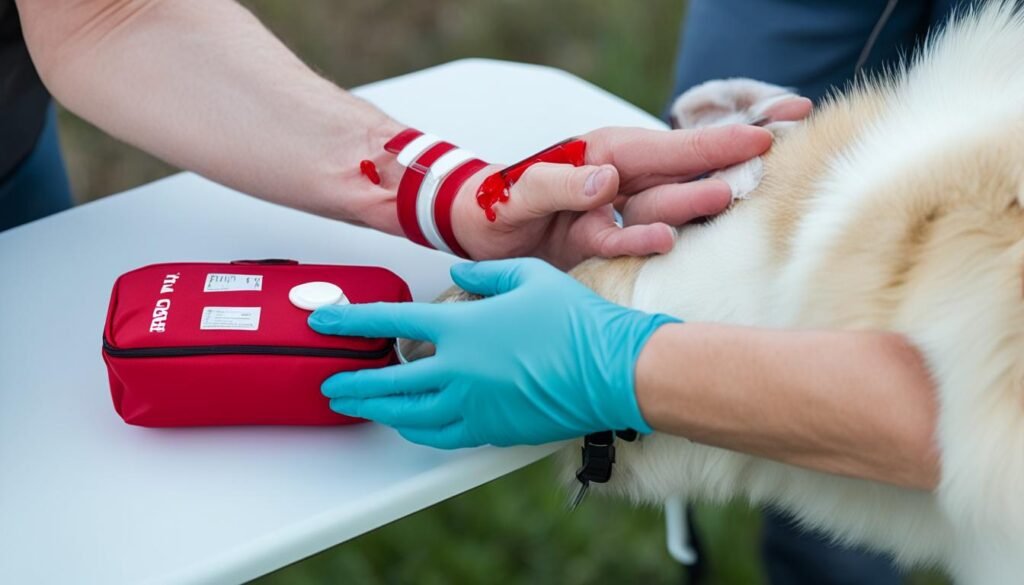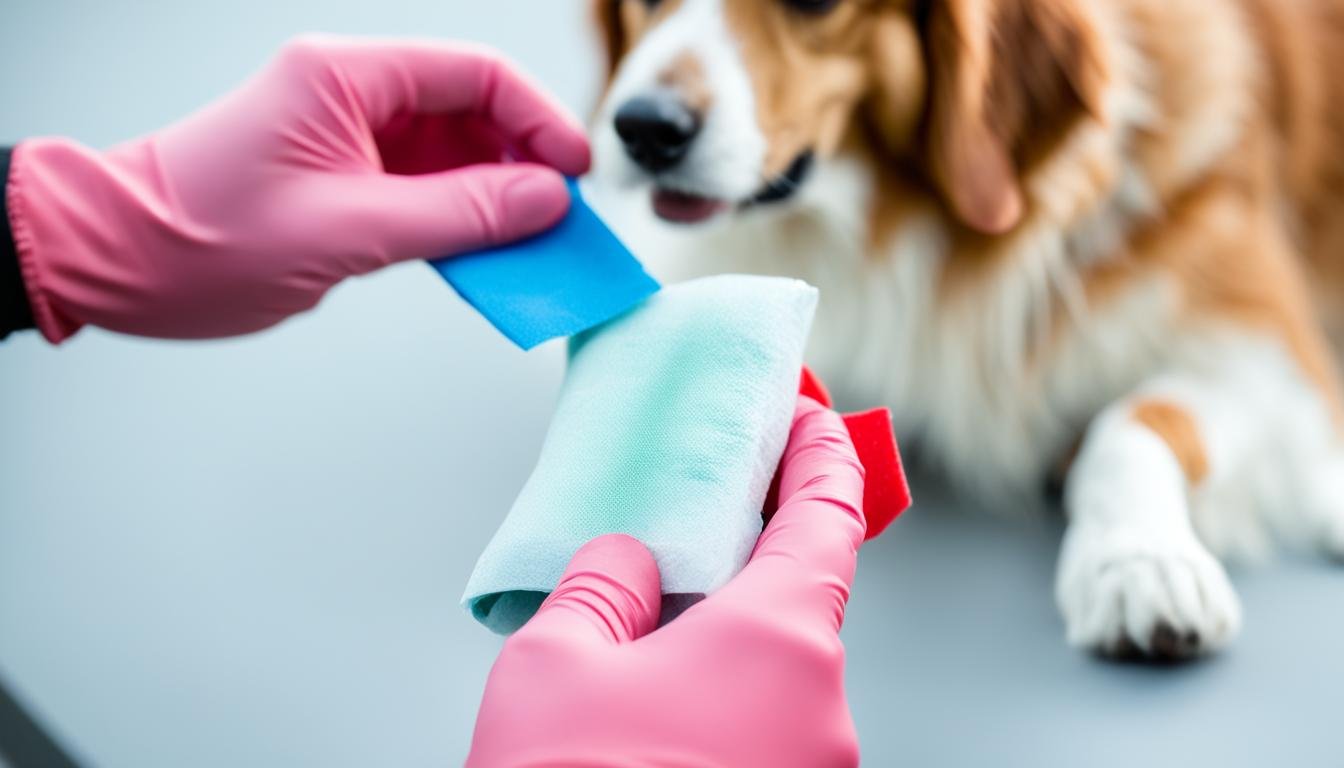About 4.5 million people in the U.S. get bitten by dogs each year.
If you or someone close gets bitten, knowing what to do is key. Acting fast and correctly can avoid serious problems and help with recovery. This article gives you a detailed guide for treating a dog bite. You’ll learn how to care for the wound and deal with legal matters.
Key Takeaways:
- Quick action is needed after a dog bite to stop infection and other issues.
- Clean the wound with gentle soap and warm water for 3 to 5 minutes.
- Put on antibacterial cream and a clean bandage.
- See a doctor for deep cuts, bites in certain places, or if infection signs appear.
- Tell the authorities about the bite and keep records for any legal or insurance needs.
Understanding Dog Bites: Types and Risks
Most animal bite incidents, including dog bites, happen with pets. Children often get bitten on the face, head, or neck. It’s important to know that different animal bites have different risks.
Dog bites are common and can get infected if not treated right. Cat bites might infect more due to cats’ long, sharp teeth. The risk of a dog bite causing infection depends on how deep the wound is and the bacteria in the dog’s mouth.
Puncture wounds from animal bites tend to get infected more than other wounds. It’s also vital to know about rabies from animal bites. Even though rabies in pets is rare, seek medical help within 24 hours for any bite that breaks the skin.
“Seeking prompt medical attention for a dog bite is essential to assess the risk of infection and the need for preventive measures against rabies.”
To understand the risks of animal bites, talking to a healthcare professional is important. They offer treatment and advice based on the particular injury. This helps prevent complications and aids quick recovery.
Knowing about animal bites and their risks helps you keep safe. Remember, getting medical help and following treatment advice is key for a good recovery.

Comparing Risks of Different Animal Bites
| Animal Type | Risk of Infection | Rabies Risk |
|---|---|---|
| Dogs | Varies based on wound severity and bacterial presence | Low risk, but seek medical attention to assess |
| Cats | Higher risk due to longer and sharper teeth | Low risk, but seek medical attention to assess |
| Other animals | Varies depending on the type of animal and wound severity | Potential risk. Seek medical attention to assess |
Remember, don’t ignore animal bites, including dog bites. It’s crucial to get medical attention fast to check infection risks and rabies prevention. Understanding the risks and acting accordingly ensures your health and safety.
Immediate Care for Dog Bites
If you get bitten by a dog, acting fast can stop complications and speed up healing. Here are simple steps to follow:
- First, wash the wound with gentle soap and warm water for 3 to 5 minutes. Cleaning the bite area helps remove germs and dirt, lowering infection chances.
- Next, apply an antibacterial ointment after cleaning. This step fights off infections and supports wound healing.
- Then, bandage the wound carefully with clean, gentle dressing. A bandage keeps the wound safe from more harm and dirty elements.
For bites on the neck, head, face, hand, fingers, or feet, see a doctor right away. These parts can easily get complications because they are close to important body parts. Also, deep cuts might need stitches and a shot for tetanus.
To clearly show what to do, here’s a table of first steps after a dog bite:
| Immediate Care Steps for Dog Bites |
|---|
| Step 1: Wash the wound with mild soap and warm water for 3 to 5 minutes. |
| Step 2: Apply an antibacterial ointment to the wound. |
| Step 3: Bandage the wound with a sterile dressing. |
| Step 4 (if applicable): Seek immediate medical attention for bites on the neck, head, face, hand, fingers, or feet. |

Quick care for dog bites is key to avoid infections and ensure the wound heals right. But remember, bites can be more or less serious. So, getting advice from a doctor for the best care is always smart.
Reporting and Documenting the Dog Bite
If you’re bitten by a dog, it’s vital to act fast to protect yourself. You should report the bite to animal control and the police. Doing this is not only important for your safety but also helps if you need to make a claim or sue.
It’s crucial to document everything about the dog bite, including your injuries. This helps prove your case and determine who is at fault. Here’s how you can document the incident effectively:
- Contacting Animal Control: Inform your local animal control about the bite. They can guide you on next steps and might start an investigation.
- Filing an Official Report: Go to your local police station and file a report. Include all key details like when and where it happened.
- Documenting Injuries: Take clear photos of your injuries quickly after the bite. These photos are proof of your injuries’ severity.
- Gathering CCTV Footage: If cameras were nearby, get the footage. It can show what happened before the bite.
- Obtaining Dog Owner’s Details: Try to get the dog owner’s contact info. This is important for any legal action you might take.
- Insurance Information: Ask the dog owner for their insurance details. This info is needed for medical bills and other claims.
By documenting the dog bite right away, you ensure you have the evidence needed for your case. This can lead to proper compensation for your injuries and holding the responsible parties accountable.
Medical Treatment and Recovery
Getting medical help quickly after a dog bite is important. It ensures you get the right care and lowers the risk of problems. You should see a doctor to check how bad the bite is and what treatment you need.
One big worry after a dog bite is getting an infection. If the bite is deep or in a certain spot, you might need antibiotics. This step is key for your recovery.
Sometimes, you may need a shot for rabies. Rabies is rare but serious. Your doctor will check if you need this shot.
If the bite is deep or serious, you might need stitches. This helps heal better and lessens scarring. The doctor will decide if you need stitches by looking at the injury.
Follow-up Care and Potential Complications
After the first medical help, following doctor’s orders is crucial. You might need more check-ups to see how the wound is healing. This helps catch any signs of infection early.
Keep track of your meds, treatments, and costs from the bite. This info is helpful for insurance or legal needs.
Complications from dog bites can happen, like infections or tendon damage. But, with the right medical care and instructions, you can heal well and avoid these issues.
Legal Considerations and Seeking Professional Help
If you’re looking into an insurance claim or personal injury case for a dog bite, understanding the legal parts is key. A personal injury lawyer who knows dog bite cases well can guide you. They can really boost your chance of a successful case.
A lawyer will examine the dog bite incident and guide you through the legal maze. They collect evidence, talk to insurance companies, and build a solid case for you. Their knowledge is key in protecting your rights and getting the compensation you need.
Getting the dog owner’s contact and insurance details is critical for a dog bite claim. Most claims are covered by the owner’s home or renter’s insurance. Your lawyer will discuss with the insurance to get a good settlement. This settlement should cover your medical bills, lost earnings, pain, suffering, and other damages.
Before you reach out to a lawyer, gather details about the bite. Take photos of your injuries, the dog, and where the bite happened. These details will make your case stronger and show how serious your injuries are.
“A personal injury lawyer specializing in dog bite cases will be your advocate throughout the legal process. They will fight for your rights and ensure that you receive fair compensation for your injuries and any emotional distress caused by the dog bite.”
Steps to Take When Contacting a Personal Injury Lawyer
| Action | Description |
|---|---|
| Research | Research and identify personal injury lawyers with experience in dog bite cases. |
| Consultation | Schedule a consultation with the lawyer to discuss your case and evaluate their expertise and approach. |
| Case Assessment | The lawyer will assess the strength of your case, including liability and damages. |
| Legal Strategy | The lawyer will develop a legal strategy tailored to your specific case, outlining the steps and potential outcomes. |
| Negotiation | The lawyer will negotiate with insurance companies to pursue a fair settlement on your behalf. |
| Litigation | If a settlement cannot be reached, the lawyer will represent you in court, advocating for your rights. |
Legal processes take time, so act quickly to meet deadlines. By hiring a lawyer who’s good with dog bite cases, you’ll handle the legal stuff with more confidence. This ups your chance of getting the compensation you rightly deserve.
Preventing Dog Bites and Promoting Safety
To prevent dog bites, teaching kids how to approach dogs is key. It’s vital they know not to go near unfamiliar animals. Also, children should never provoke or tease them to avoid potential harm.
By teaching these principles early, we ensure kids stay safe from dog bites. This creates a safer space for everyone.
When you see a stray or a dog without an owner, be careful. Don’t go near the dog. Instead, call the police or animal control for help.
They know how to safely handle such situations. It’s always best to be cautious with dogs you don’t know.
Learning how to safely interact with dogs is crucial. Kids need to learn to be polite and respectful around dogs. This includes in their own homes and out in public.
Teach kids to move slowly and let a dog get to know them first. This helps avoid any scares or bites.
Before touching a dog, children should always ask the owner’s permission. They should approach from the side, not straight on. And they should steer clear of quick moves, loud sounds, or making eye contact.
“Proper education and awareness can go a long way in preventing dog bites. By teaching children about safe interaction with dogs and instilling respect for animals, we can create a safer environment for both humans and pets.”
Teaching Children about Dog Safety
Remember these points for child and dog safety:
- Never approach unfamiliar dogs without permission
- Avoid teasing, provoking, or startling dogs
- Always approach dogs slowly and calmly
- Ask the owner for permission before petting or interacting with a dog
- Approach dogs from the side, rather than head-on
- Avoid making sudden movements, loud noises, or direct eye contact with dogs
By sticking to these rules and teaching kids about dog safety, we can cut down on dog bites. This makes a safer space for all.
Conclusion
Getting better from a dog bite needs quick action and the right care. You can make recovery smoother by following this guide. Start with first aid right after the bite. Clean the wound with soap and warm water. Then, apply antibacterial ointment and cover it with a clean bandage. For deep wounds or bites on the face or hands, it’s important to see a doctor.
Sometimes, you might need a lawyer to protect your rights and get compensation. Talk to a dog bite lawyer who knows about personal injury laws. They can gather evidence, deal with insurance companies, and help get a fair settlement.
It’s very important to prevent more dog bites for your safety and others. Learn and teach your family how to avoid dog bites. Explain to kids how to safely be around dogs. If you see a dog that’s loose or acting mean, be careful and tell the authorities.
To heal from a dog bite and avoid more in the future, do a few things. Give first aid right away, get medical help, think about legal advice if needed, and prevent dog bites. Be smart, stay safe, and help make your community a better place for dogs and people.

